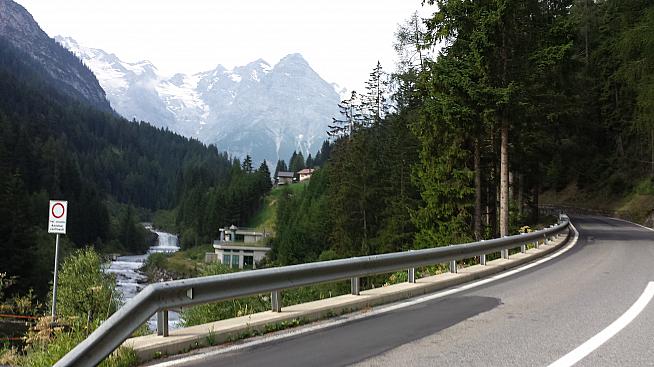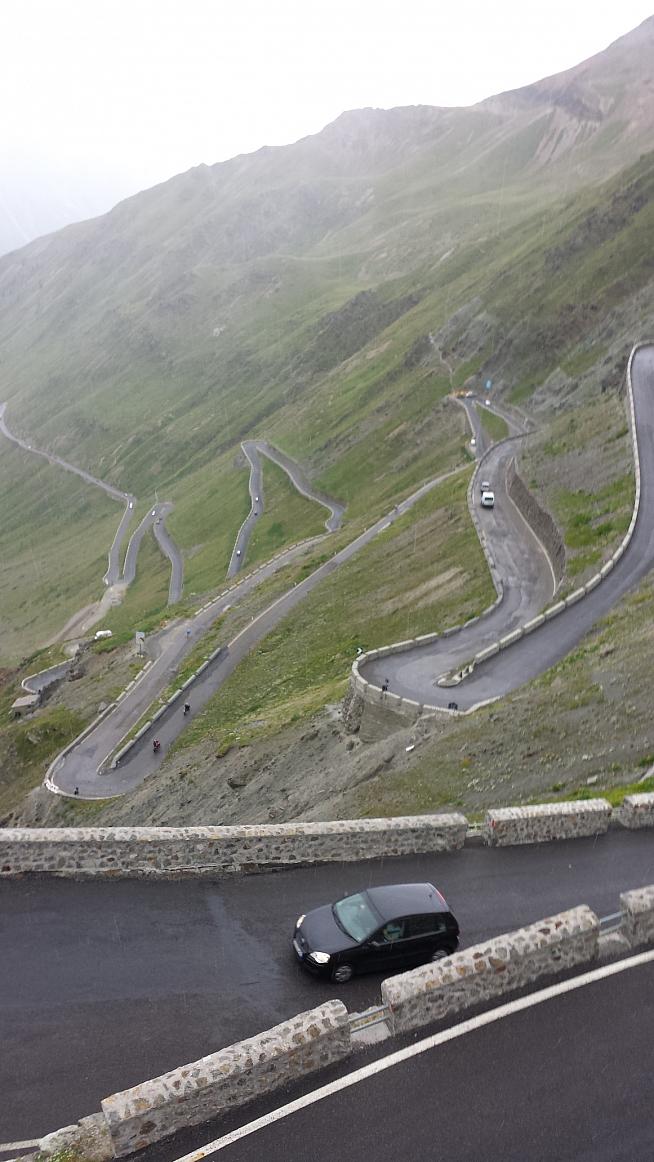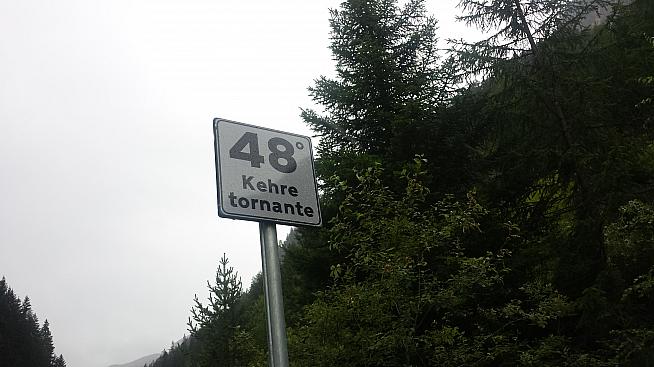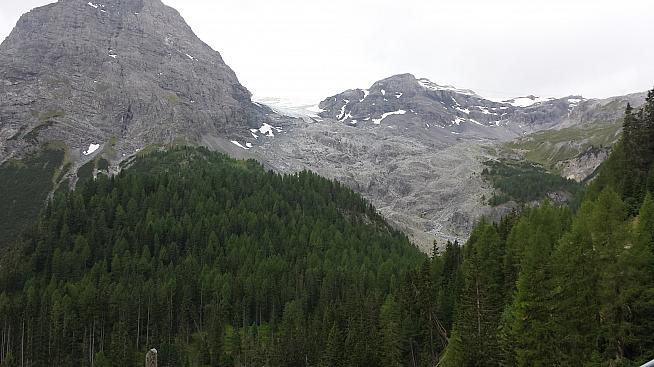The climb to the Stelvio Pass is one of the legendary routes in Italian cycling and has been frequently used in the Giro d'Italia, most recently in 2012. It has achieved a somewhat legendary status among sportive cyclists, although it is less popular than some other climbs because of its location in the eastern Alps. At 2,757 metres high it is the second highest paved climb in the Alps, second only to the Col d'Iseran which is just 13 metres higher.

I had always wanted to climb the Stelvio Pass (Stilfser Joch in German, which is widely spoken in the region) and on 7 August, 2013 I got the chance to during a family holiday. Having suffered the previous week climbing the Col de l'Izoard because of the extreme heat in the middle of the day I decided to start early. There was no question of which route I wanted to take - the famous 48 hair pin bends on the northern side, climbing up from Prato Allo Stelvio, rather than the less challenging (slightly) climb from Bormio. I was staying near Merano (Meran) and contemplated cycling along the valley to Prato but was glad that I did not as it was a narrow and busy road (the SS38) which at that time of the morning was being used by a lot of lorries and even more commuters who were in a hurry to get to work and giving the few cyclists I saw on the road not very much room.

By 9.30am I was in the car park in the centre of Prato Allo Stelvio, which is generally considered the best starting point for the northern climb. There were a few other cyclists in the car park, although I found that as I cycled out of the village that there is another car park on the northern edge where most road cyclists seem to park. As I passed the village exit sign I started the timer on my Garmin.
Conditions were good at 22 degrees and with a light wind and the first four kilometres went easily as it is pretty gentle climbing at a gradient of just over 5 per cent. There were already plenty of motorcycles and cars on the road as the Stelvio Pass is legendary among bikers and petrolheads too, having been voted one of the best driving roads in Europe. I found that most of the motorists were pretty considerate of cylists, although the Romanian drivers seemed to be an exception to this and a few drivers seemed to think that the best way to indicate to you that they were directly behind you on a bend was a sharp blast of their horn to let me know they were there (which was disconserting but not meant to be aggressive).
After 7km you pass through the village of Gomagoi and a kilometre later you cross over the river Trafoi, pass under a concrete structure designed to stop rocks from avalanches hitting you and then you hit the first hairpin bend, number 48. It is here that the proper climbing begins. The first four hairpin bends are fairly spaced out (you have to go through the village of Trafoi to get to no 46) and you begin to wonder how long this can go on for. At this time a light rain started falling, which was quite nice and cooling.

I got into a good rhythm and found that post bend no 40 that they started coming fairly frequently and that kept the spirits up as you could feel a real sense of counting down to the summit. The rain had also stopped, although there was still about a 20km/h wind, which was reasonably cooling. From this point you can also see the mountain ahead of you, with plenty of snow still there even in August.
From bends no 40 to about no 21 the climb is a fairly consistent 8 degrees with a slight relenting in the climb at each bend but at no 21 it ramps up a little and there are sections where the climb is as much as 13 degrees and there is a 2km stretch which definitely tests the mental resolve.
But the key thing is that by this time you are above the treeline and you can see the legendary bends of the climb up to the summit set ahead of you and you can see fellow cyclists slowing ascending above you.

At roughly bend no 14 there was a photograph from Stelvio Foto (he takes your picture and then you can buy it on the Internet when he finally decides to upload it about five days later...an interesting contrast to the French equivalent which is posted the evening of your ride when you are still elated enough to pay 10 euros for a single picture), which caused me to focus on looking serious and not too pained (probably unsuccessfully) and by that time I knew I could complete the ride without stopping (which I had really wanted to do).
On the climb there is now countdown of the distance completed until 5km to go when the distance is painted on the road and the same is true at 4km, 3km, 2km, 1km and with 500 metres and 100 metres to go. With about 4km to go the wind and rain really started to make themselves known. A steady shower would have been fine but a roughly 35km/h headwind ensured a bit of a battering on the last push to the top, coupled with sharply lower temperatures. The weather forecast had been for fine weather throughout the day, so anyone contemplating the Stelvio ride should be aware that conditions are extremely changeable.
Fortunately with about 3km to go I got sight of a couple of mountain bikers climbing roughly a bend ahead and I set them as my target to overtake, which I did with about 1km to go. I then saw a couple more riders roughly 50 metres ahead and I set them as my next target and just overhauled them with about 30 metres to go.

I arrived at the summit in 2 hours 28 minutes, which was a bit slower than I had imagined I would do it in but in retrospect I was pretty happy with. I've done very little training this year aside from a few spins up Highgate West Hill and Swains Lane and given that the climb is 25km (according to my Garmin) and has a vertical ascent of 1,808 metres (so an average of 7.4 degrees) I probably should have trained a bit harder. One of the great satisfactions was that no-one (on a bike) overtook me during the entire climb, which probably means all the good riders were going out a bit later in the day.
The summit was full of bikers, cylists and shops selling tat, although the amount of selling going on was somewhat limited by the high winds, the cold (it was down to about 3 degrees centigrade) and the rain and most of the shopkeepers were busy battoning down the hatches. I was very glad I had a rain jacket to put on, although I only put it on after getting a German biker to take a picture of me next to the Stelvio Pass sign.
I passed on the opportunity to buy a special Stelvio Pass cycling jersey (quite attractive and available in pink for female riders only but 65 euros for a jersey I might wear once a year seemed slightly pointless) and decided that getting off the mountain might be a good idea. Unfortunately the conditions didn't make for easy descending as I couldn't see much through my rain and mud spattered glasses and a lot of the motorists were being extremely cautious too, meaning that if you got up above 35kp/h you started to worry about whether you really could stop before slamming into the back of a car on one of the hairpin bends.

Fortunately after about bend no 12 I managed to pass about nine cars and then was able to descend virtually unimpeded back to Prato Allo Stelvio (apart from stopping to take a couple of pictures) and was able to get up to a maximum speed of 68.8kp/h. The conditions became a little drier the lower down I got but it was still quite cold and my teeth were chattering for much of the descent.
I arrived back in Prato Allo Stelvio a little wet and mud spattered but otherwise elated. The Stelvio is one of the great Alpine rides and it is certainly one I will be back to try again (hopefully a little faster) another time.
1 Comments





